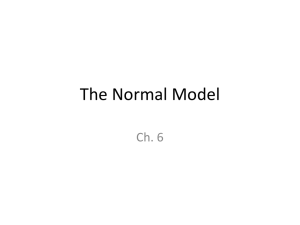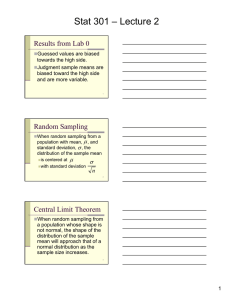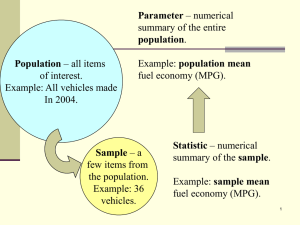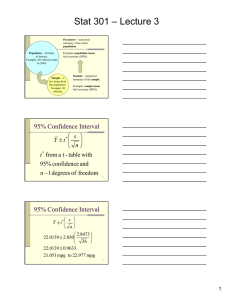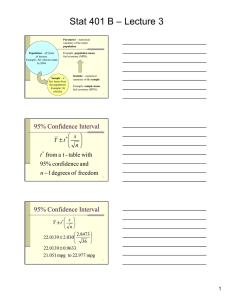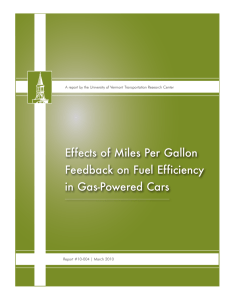Results from Lab 0
advertisement
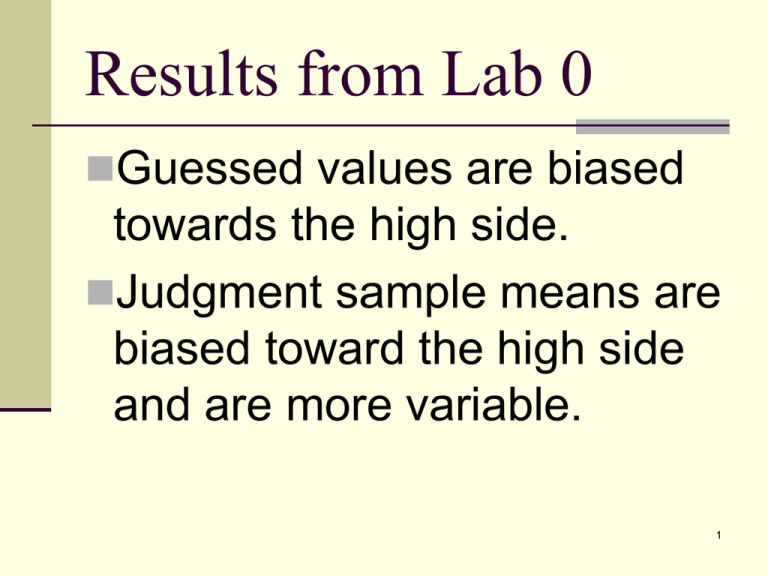
Results from Lab 0 Guessed values are biased towards the high side. Judgment sample means are biased toward the high side and are more variable. 1 Random Sampling When random sampling from a population with mean, , and standard deviation, , the distribution of the sample mean is centered at with standard deviation n 2 Central Limit Theorem When random sampling from a population whose shape is not normal, the shape of the distribution of the sample mean will approach the normal as the sample size increases. 3 Statistical Thinking Starts with a question – Did cars and trucks made in 2004 meet the Corporate Average Fuel Economy (CAFE) standard? 4 Statistical Thinking What data would help us answer this question? Data on average fuel economy for a random sample of cars and trucks. 5 Fuel Economy Data (MPG) 26.5 21.0 17.0 20.0 22.0 24.0 24.5 21.5 22.0 25.0 29.0 23.0 25.0 24.0 22.0 22.5 18.0 22.5 25.0 21.0 22.0 19.5 18.5 25.5 24.5 23.5 22.0 19.5 17.5 18.0 23.0 20.5 21.0 16.0 23.5 22.5 6 Average Fuel Economy Y 22.0139 mpg Why is this a meaningful summary? How do you interpret the sample average (mean) value? 7 What other summaries? Stem and leaf Five number summary Box plot Histogram Sample standard deviation 8 Stem and Leaf 29 28 27 26 25 24 23 22 21 20 19 18 17 16 0 5 0005 0055 0055 00000555 0005 05 55 005 05 0 Maximum = 29.0 mpg Upper Quartile = 24.0 mpg Median = 22.0 mpg Lower Quartile = 20.25 mpg Minimum = 16.0 mpg 9 Box plot, Histogram Distributions Average MPG 10 6 Count 8 4 2 15 17.5 20 22.5 25 27.5 30 10 Mean and standard deviation Distributions Average MPG Moments Mean Std Dev Std Err Mean upper 95% Mean low er 95% Mean N 22.013889 2.8472696 0.4745449 22.977266 21.050511 36 11 Statistical Inference So far we have looked as displaying and summarizing sample data. What do these data tell us about all cars and trucks in 2004. 12 Parameter – numerical summary of the entire population. Population – all items of interest. Example: All vehicles made In 2004. Example: population mean fuel economy (MPG). Sample – a few items from the population. Example: 36 vehicles. Statistic – numerical summary of the sample. Example: sample mean fuel economy (MPG). 13 One-sample model Y •Y represents a value of the variable of interest • represents the population mean • represents the random error associated with an observation 14 Conditions The random error term, , is Independent Identically distributed Normally distributed with standard deviation, 15 Confidence Intervals A set of reasonable or plausible values for the population mean. We can state how confident we are that intervals based on random samples actually capture the population mean. 16 95% Confidence Interval s Y t n * t from a t - table with 95% confidence and n 1 degrees of freedom * 17 95% Confidence Interval s Y t n 2.8473 22.0139 2.030 36 22.0139 0.9633 * 21.051 mpg to 22.977 mpg 18
